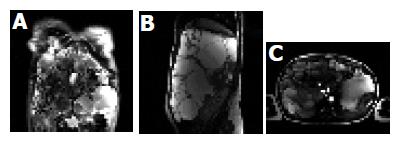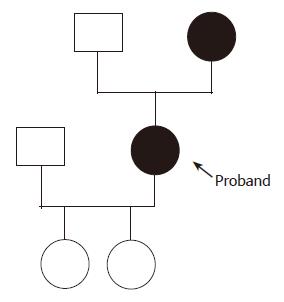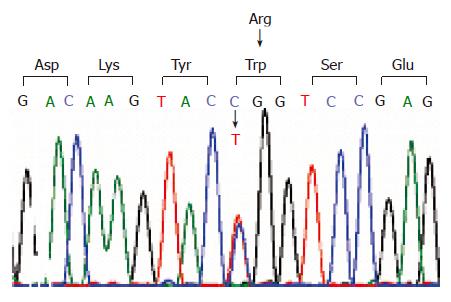Copyright
©2005 Baishideng Publishing Group Inc.
World J Gastroenterol. Dec 28, 2005; 11(48): 7690-7693
Published online Dec 28, 2005. doi: 10.3748/wjg.v11.i48.7690
Published online Dec 28, 2005. doi: 10.3748/wjg.v11.i48.7690
Figure 1 Massive polycystic liver disease on coronal MR imaging (A), caudal and posterior displacement of abdominal organs by the massively enlarged liver on sagittal MR imaging (B), and compression of the inferior vena cava (arrow) produced by the massively enlarged liver (C) on MR angiograph.
Figure 2 Family pedigree of the patient.
Figure 3 Sequence identification of the C>T changes in exon 10.
This mutation, C841T which is predicted to change the amino acid composition of hepatocystin, changes arginine to tryptophan at codon 281 (R281W).
Figure 4 Schematic representation of hepatocystin.
The position of PRKCSH mutations that have been associated with PCLD are superimposed on the structure of hepatocystin. The new mutation detected in our family is indicated on top. The numbers reflect the amino acid numbering of hepatocystin. LDLa: low-density lipoprotein receptor domain A; EF: EF-hand calcium-binding domains; MPR: mannose 6-phosphate receptor domain.
- Citation: Peces R, Drenth JP, Morsche RHT, González P, Peces C. Autosomal dominant polycystic liver disease in a family without polycystic kidney disease associated with a novel missense protein kinase C substrate 80K-H mutation. World J Gastroenterol 2005; 11(48): 7690-7693
- URL: https://www.wjgnet.com/1007-9327/full/v11/i48/7690.htm
- DOI: https://dx.doi.org/10.3748/wjg.v11.i48.7690












